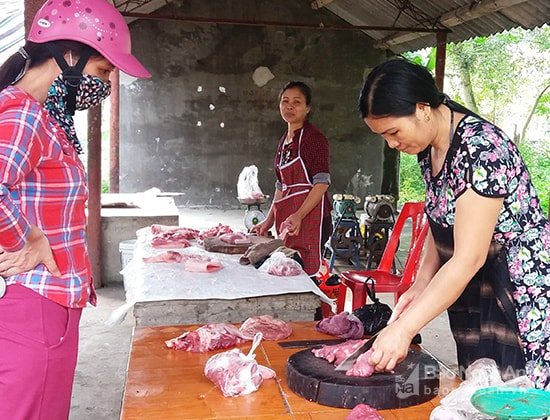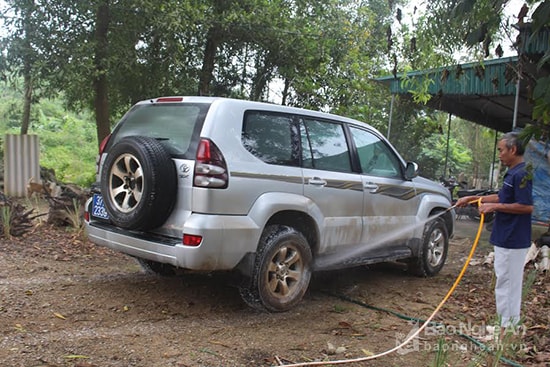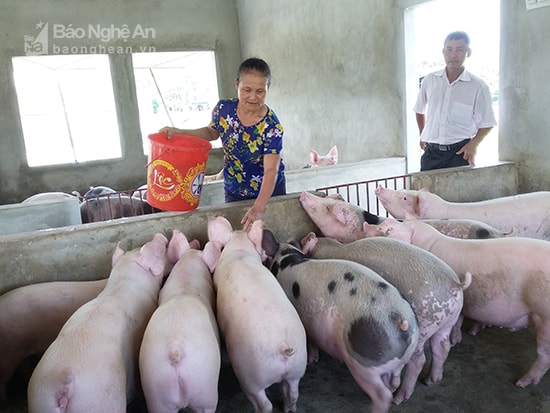Sustainable pig farming: Focus on providing output for people
(Baonghean) - To limit the oversupply of pigs, besides focusing on input services, the important issue is to consider ensuring stable output.
» Amidst the 'price storm', local pigs are still in high demand
» Linkage - effective solution in pig farming
» Nghe An: Why is pig farming struggling?
» Pig price has increased by 5,000 - 7,000 VND/kg
In the province's agricultural structure, livestock farming is identified as one of the breakthroughs. Currently, the province has 292 farms and hundreds of thousands of households raising pigs, with a total herd of nearly 900,000 pigs, of which 198 are pig farms. To limit the oversupply of pigs, in addition to focusing on input services, the important issue is to consider ensuring stable output. Clean production and increasing the value chain in pig farming are problems that need to be solved by all levels, sectors and farmers.
Correct identification of pig farming process
Currently, many families in Nam Dan, Hung Nguyen, Nghi Loc districts... are having to manually slaughter pigs to "rescue" pigs in their villages and homes. This is a temporary measure in difficult times, even though China has resumed purchasing in small quantities. Central sectors and levels have made some moves to "rescue" pigs, but there has not been much movement in localities. Some local leaders, when asked, said they were "helpless".
 |
| Pork is sold at Can market, Hung Tan commune (Hung Nguyen). Photo: Thanh Tam |
Currently, most farms are mortgaging their land titles to borrow capital and the interest is compounding. Mr. Tran Quoc Trung - Chairman of the Farm Association in Hung Nguyen district said that he is currently trying to find all sources of capital in his family as well as borrowing to maintain a herd of 500 pigs to eat every day, while slaughtering each pig is impossible, because each time entering the pen, it must be disinfected, which takes a lot of time, and the cost of disinfection is 500,000 VND. While selling one pig is a loss of millions of VND, he has to find a source to sell 50 pigs, 100 pigs...
Nationwide, processing enterprises still have many limitations in terms of slaughtering capacity, freezing and processing to diversify pork products, while foreign markets have increased quality monitoring and restricted the import of live pigs. In Nghe An, pork is mainly sold in markets and is difficult or not yet available in supermarkets. Traceability of clean pork origin to reassure consumers has not been implemented.
In reality, pig farming and many other agricultural products can only ensure sustainability and efficiency when organized into a chain from feed production, breeding, to purchasing, transporting and processing. That value chain must be better controlled in terms of quality, food safety and traceability. Nghe An's pig products need to be branded, meeting the standards and regulations of domestic purchasing and processing enterprises and those of importing countries. If a value chain appears in pig farming, such as having product purchasers, processing and exporting factories, then nearly 1 million pigs of Nghe An and nearly 800,000 buffaloes and cows will have a brighter future.
In addition to directing localities to develop detailed plans for livestock production development areas in accordance with the overall agricultural planning. At the same time, the province also needs to have appropriate policies to support and create favorable legal conditions to attract businesses to invest in livestock development in the direction of strengthening close links between businesses and farmers in all stages. Businesses must take on the role of driving force, organizing production, providing scientific and technological advances and developing consumption markets.
According to Mr. Hoang Nghia Hieu - Director of the Department of Agriculture and Rural Development, companies and enterprises need to focus on prioritizing the development of contract farming in areas that do not have advantages for crop cultivation such as infertile land, poor nutrition, low crop yields to improve the efficiency of using organic fertilizer from livestock for crops to increase crop yields, while promoting the formation of new crop - livestock systems. And for this link to bring long-term profits to farmers, farm owners must seriously implement the livestock farming process set out by companies and enterprises in effectively using the provided feed and materials and minimizing diseases... Only then will contract farming become a sustainable economic development direction, and at the same time be a driving force to promote industrial-scale livestock farming in the province.
 |
| Spraying disinfectant on vehicles entering the farm. Photo: Phu Huong |
Proactive solutions to improve livestock value
Recently, many consumers have doubts about the quality of pork on the market, they often go back to their hometowns to buy clean pork or buy meat when they know the origin. Sidewalk pigs brought down by farmers in Thanh Chuong, Nam Dan, Con Cuong... have somewhat dominated the city market, threatening pork in the markets. Phrases such as super lean, super plump... are questioned by many people.
The Livestock Competitiveness and Food Safety Project (LIFSAP) implemented by the Ministry of Agriculture and Rural Development in Nghe An since 2010, with the goal of improving the competitiveness of livestock households through improving productivity, quality, food safety and minimizing environmental pollution towards clean livestock farming from farm to table has also been implemented.
After 5 years, up to now, Nghe An has established 4 good livestock practice areas (GAHP), with 10 GAHP points, 30 groups including 599 participating households. The project has invested in equipment, goods and knowledge training for livestock households, food businesses, authorities at all levels, agricultural extension staff, veterinary staff, and supported the upgrading of 4 centralized slaughterhouses in: Nam Nghia commune (Nam Dan), Hop Thanh commune (Yen Thanh), Nghi Dong commune (Nghi Loc) and Dien Tho commune (Dien Chau). At the same time, it supported the upgrading of 16 small slaughterhouses. In addition, the project also renovated, upgraded and handed over 41 fresh food markets for use. The project also invested in upgrading 14 food markets, upgrading buffalo and cow trading markets such as U Do Luong market.... These are good signs in improving the quality of pork supply, creating a good impression on consumers in the area. However, the project's spread has not been strongly promoted in localities.
 |
| The pigs are about to be sold in Mrs. Hang's family, hamlet 15B, Nghi Kieu commune (Nghi Loc). |
To continue to increase the economic value of livestock farming in the direction of disease safety, farm owners should soon recognize the root cause to improve product quality, creating delicious, fragrant meat products that attract consumers.
Currently, some factories have sent engineers to the area to guide farmers in raising pigs using biological methods, using probiotics to ferment feed, taking advantage of seasonal feed by-products such as corn, cassava, potatoes, and limiting industrial feed. Mr. Nguyen Van Thang - Director of the Golden Pig Feed Factory said that with the method of fermenting feed with probiotics, farmers save nearly half of the feed cost, while also producing delicious meat products, because pigs are fed natural food, reducing industrial feed.
In general, sustainable livestock farming requires macro-regulatory solutions, including improvements in breeds, feed, and livestock costs, meat quality, and output. The government, ministries, and sectors should soon regulate supply sources during integration, and not lose at home like they are doing now.
On the local side, Dr. Nguyen Minh Phong, an economist, stated his opinion: Nghe An is the largest province in the country, the livestock industry is increasingly developing, so it is necessary to grasp overall information across the country as well as information on integration and livestock development associated with forecasts and requirements of the product consumption market. At the same time, it is necessary to increase the application of advanced technology, save costs, reduce prices from breeds, feed, veterinary drugs, improve productivity, quality and deep processing of livestock products. To do so, it is necessary to proactively review and adjust the scale and structure of the pig herd, focus on the quality of breeding herds, and livestock farming methods suitable for each market segment; organize well-connected programs, sign purchasing, processing and freezing contracts with domestic enterprises.
In attracting investment, we also need to avoid over-investment and balance between modern and traditional local livestock farming. That is the theory, but to apply it in practice, livestock farmers need the active participation of authorities and businesses in the coming period.
Chau Lan - Phu Huong
| RELATED NEWS |
|---|

